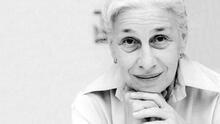Gail Rubin
Gail Rubin found her life’s passion as a photographer, documenting the beauty of Israel’s ecosystems. Rubin graduated from Finch College in New York in 1960 and began working as an editor at Viking Press, eventually becoming managing editor for Delacorte Books. In 1969, while vacationing in Israel, Rubin became enamored of the land and its people and quit her job to become a press photographer there. She was one of the first civilians to travel with Israeli soldiers to Egypt during the The Day of Atonement, which falls on the 10th day of the Hebrew month of Tishrei and is devoted to prayer and fasting.Yom Kippur War. In 1978, Rubin was photographing rare birds on a beach near Ma’agan Michael when terrorists landed nearby and discovered her. She was interrogated, shot, and killed. Her death was mourned both in Israel and America.
In 1979, Rabbi Michael Graetz wrote that the photographer Gail Rubin “had a sense of being present at the day of creation.... Development of life was her deepest inspiration. Her animals are less often seen alone than in families or groups—she discerned within nature a love pervading all the universe, a love which for her was expressed even in rock formations and trees.” The work of Gail Rubin reflects a love and respect for all aspects of the Israeli landscape as much as it reflects a passion for life.
Gail Rubin’s photographic career ended tragically at age thirty-nine when, on March 11, 1978, she was murdered by Arab terrorists on a beach near Ma’agan Michael. At the time, Rubin was photographing rare birds. When the terrorists landed on the beach in rubber boats, they discovered Rubin. After asking her a number of questions, they shot her.
Family & Education
Rubin was born in New York City, on April 12, 1938, the only child of Jonathan and Estelle Rubin. Jonathan Rubin was a vice president and treasurer of Krasdale Foods. Estelle Rubin was a psychotherapist. In New York, Rubin attended the Dalton School, graduating in 1956, and began her undergraduate career at the University of Michigan. Rubin completed her undergraduate studies at Finch College in New York in 1960. Upon completing her degree, Rubin began working in an editorial position at Viking Press and New Directions, until she became managing editor at Delacorte Books.
Press & Nature Photography in Israel
In June of 1969, Rubin traveled to Israel for a short vacation. Fascinated by the land and the people, she decided to remain in Israel. In Israel, Rubin began working as a press photographer. At this time, Rubin primarily used black-and-white photos. She was one of the first civilians to travel to Egypt with Israeli soldiers during the The Day of Atonement, which falls on the 10th day of the Hebrew month of Tishrei and is devoted to prayer and fasting.Yom KippurYom KippurThe Day of Atonement, which falls on the 10th day of the Hebrew month of Tishrei and is devoted to prayer and fasting.Yom Kippur War in 1973. In 1973, Rubin began to concentrate her work on the natural landscape, using color photos. According to her parents, Rubin had intended eventually to return to the United States.
In her photos of Israeli nature, Rubin focused her attention on diverse objects, including birds, water buffalo, butterflies, mountains, and bodies of water. Rubin complemented her photographs with a knowledge of local history and detailed observations. For example, accompanying her stunning photo of the Hula Lake in the Hula Nature Reserve in the Galil in northern Israel, Rubin discusses the history of the tension between the halutzim, the pioneer settlers in Israel, and those individuals whose concern for natural conservation led to the creation of the reserve. Rubin comments on the effect of the settlers on the land: “The balance of life was upset. The natural order destroyed. The interrelationship of amphibian, mammal, and birdlife and swamp vegetation vanished.... The vast swamplands, once the scene of constantly changing birdlife—ducks, herons, pelicans—fell silent.” Rubin’s work reflects her love of the land of Israel and her desire to capture its uniqueness and beauty.
Selected Works by Gail Rubin
Psalmist with a Camera (1979).
Rubin’s photographs appeared in the December 1977 publication of Natural History in the article “Eucalyptus Bark” by Edward S. Ayensu and in the January 1978 publication of Natural History in the article “Ibex in Israel” by Len Aronson. Rubin’s work can also be found in U.S. Camera, Time-Life’s Nature Science Annual 1976, Time-Life’s Birds of Sea, Shore and Stream, Life in Zoos and Preserves, and Time-Life’s Photography Annual 1979. Rubin’s photographs were exhibited at the Jewish Museum in New York in February of 1977, the Magnes Museum in Berkeley, California, and the Israel Museum in Jerusalem.
AJYB 80:371.
“Israelis at Funeral for Gail Rubin.” NYTimes, March 18, 1978, 26:4.
“Memorial Meeting Is Held for U.S. Victim of P.L.O. Attack on Israel.” NYTimes, March 17, 1978, 9:2.
Natural History 87 (June 1978): 4.
“U.S. Born Photographer Was First Victim in the Raid.” NYTimes, March 13, 1978, 11:1.














